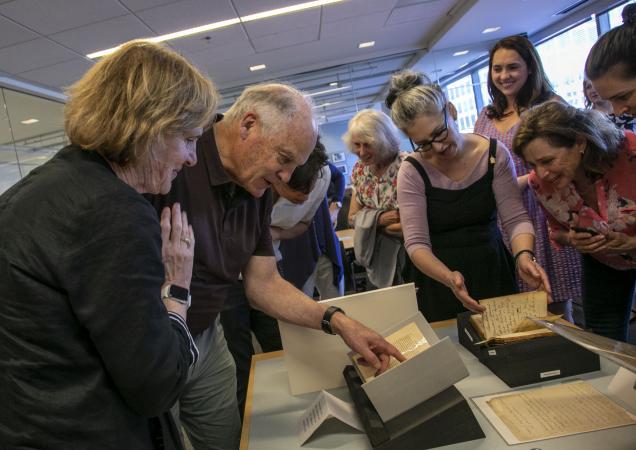On June 10 and 11, 2019, the Hungerford Family visited the Smithsonian for the first time. Who are the Hungerfords, you ask? They are descendants of the family of Elizabeth Hungerford Keate Macie (1728-1800), the mother of British scientist and Smithsonian founding donor James Smithson (1765-1829). Smithson was born James Louis Macie in 1765 to Elizabeth Hungerford Keate Macie, a wealthy widow from the region near Bath, England. Hugh Smithson (1714-1786), later known as Sir Hugh Percy, Duke of Northumberland, was James Macie’s father, though Smithson never acknowledged his son. Still, in 1800, after the death of his mother, James Macie took his father’s family name, becoming James Smithson.

Smithson’s father’s family, the Northumberlands, had been in touch with the Smithsonian regularly and had visited several times, but the Hungerfords had not. It was assumed that James Smithson’s money came from his father, and little attention was paid to his mother’s family. A recent Smithson biography by Heather P. Ewing demonstrated that it was Hungerford money, not Smithson money, that founded the Smithsonian Institution. James Smithson had inherited a piece of the Hungerford family estate and, as a shrewd investor, had parlayed it into a much larger fortune that he left to found an institution for the “increase and diffusion of knowledge.”
A Northumberland family member suggested to a Hungerford family member that they read the Ewing book, and it got passed around the family. Delighted to learn about a relative’s role in creating the Smithsonian, the Hungerfords were determined to visit.

Periodically the Hungerfords take family reunion trips to interesting locations, and in 2019 it was to James Smithson’s institution. Some thirty-one family members, from England, Canada, and other locations, met at the Smithsonian for a two-day whirlwind visit to eight separate Smithsonian facilities, including the Castle, National Museum of American History, National Museum of Natural History, National Portrait Gallery, National Museum of African American History and Culture, National Air and Space Museum, Mitsami Café at the National Museum of the American Indian, Smithsonian Libraries and, most importantly (at least to us!) the Smithsonian Institution Archives.
Coincidentally, shortly before their visit, a Smithsonian American Art Museum board member had purchased a historic document, and donated it to Smithsonian Archives. It is an “Indenture” tripartite, or three-way contract, that documented the transfer of lands through generations of the Hungerford family. Our talented conservator, William Bennett, displayed this very large multipage parchment document and discussed its meaning and history. The Hungerfords (and our staff) were quite excited at this first viewing of the document and it was a highlight of the trip. We’d like to think the Hungerfords were quite impressed with our collections, and we were certainly happy to have them visit the Archives!

Want to learn even more about the indenture tripartite? Tune in for a blog post on Thursday, September 5 by conservator William Bennett, who has become our resident expert on the document.
Related Resources
- James Smithson, Founding Donor, Smithsonian Institution Archives
- The Lost World of James Smithson, by Heather P. Ewing, Smithsonian Magazine
- Smithson’s Library, Smithsonian Institution Libraries
Produced by the Smithsonian Institution Archives. For copyright questions, please see the Terms of Use.

Leave a Comment